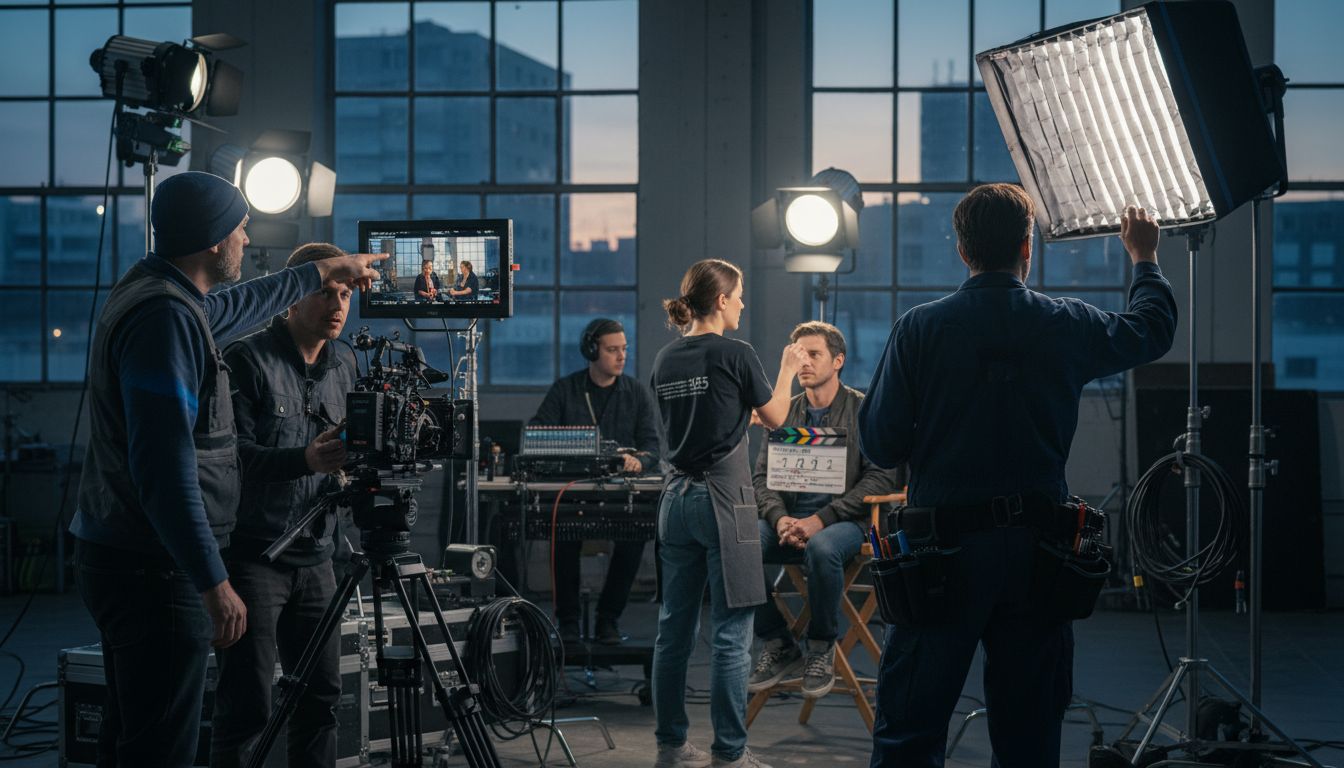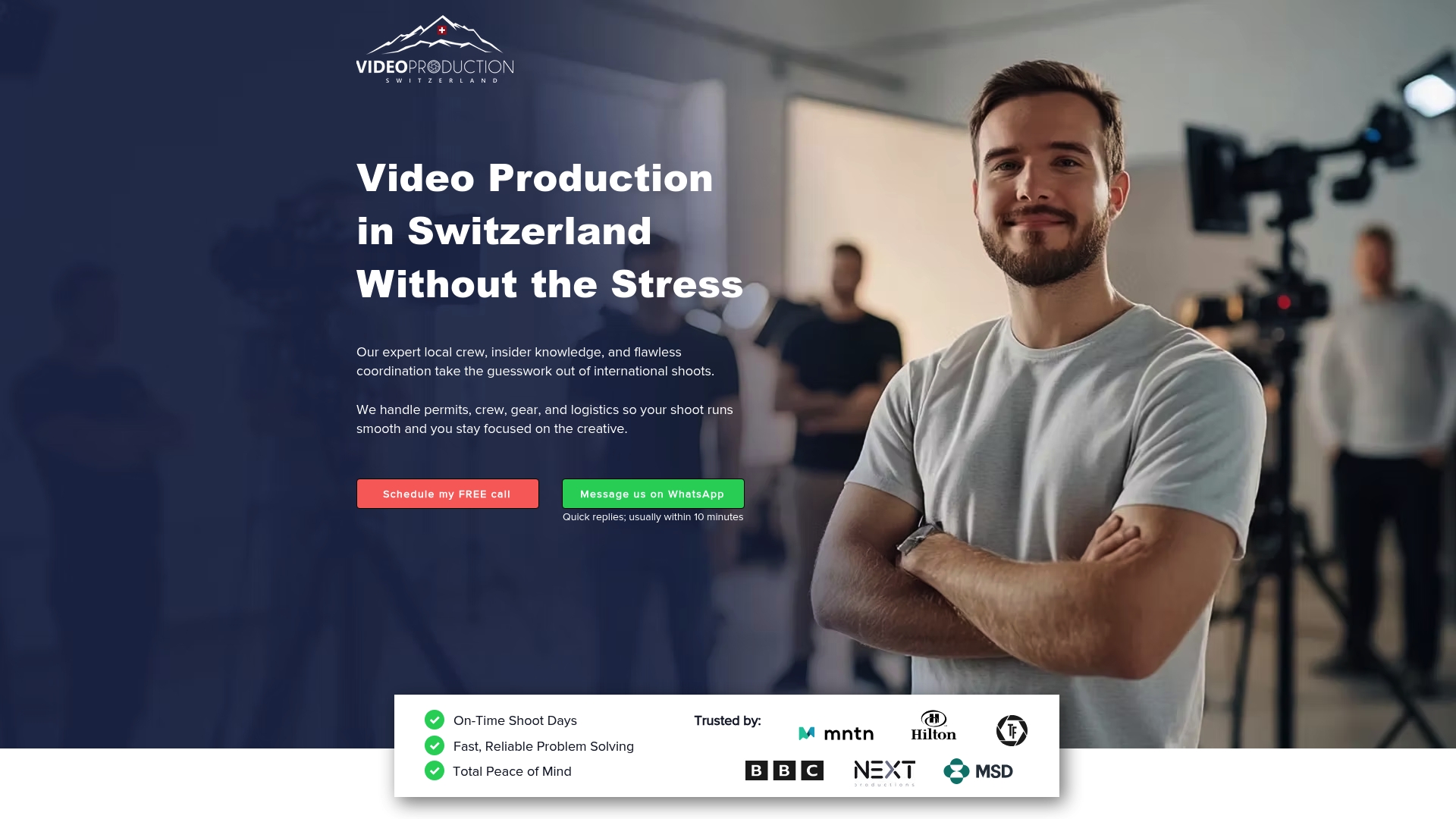Complete Guide to Video Production Workflow
- info1419758
- 11 minutes ago
- 8 min read

Creating a professional video requires more than just a camera and a script. Companies spend up to 70 percent of their video budget in pre-production and planning alone, illustrating how process can make or break a project. Whether you are new to video projects or aiming to improve quality, understanding each step in the production workflow helps you avoid costly mistakes and ensures your creative ideas come to life with clarity and impact.
Table of Contents
Key Takeaways
Point | Details |
Video Production Phases | The video production process consists of three primary phases: pre-production, production, and post-production, each essential for successful outcomes. |
Importance of Pre-Production | Comprehensive planning, including scripting and scouting, is critical during the pre-production phase to set clear project trajectories. |
Role of Professionals | Diverse roles, such as directors and editors, contribute uniquely across all production stages and must coordinate effectively for optimal results. |
Common Challenges | Workflow mistakes such as inadequate planning and communication issues can severely disrupt video production and should be proactively addressed. |
Defining Video Production Workflow Processes
Video production is a systematic approach to creating visual content that transforms creative concepts into compelling visual narratives. According to McGill University, video production is typically divided into three fundamental phases: pre-production, production, and post-production, each representing a critical stage in bringing a visual story to life.
The pre-production phase serves as the strategic foundation of any video project. This initial stage involves comprehensive planning, scripting, and preparation that sets the trajectory for the entire production. As KU Leuven explains, pre-production lays the groundwork by developing detailed scripts, storyboarding key scenes, scouting locations, casting talent, and establishing the overall creative vision.
Key Components of Video Production Workflow
A robust video production workflow encompasses several interconnected components that ensure smooth execution:
Conceptualization: Developing the initial creative concept and narrative
Scripting: Writing detailed screenplay and shot descriptions
Resource Planning: Identifying necessary equipment, personnel, and budget
Location Scouting: Selecting and securing appropriate filming environments
Talent Acquisition: Casting actors or presenters for the project
The production phase represents the actual filming stage, where meticulously planned concepts transform into tangible visual content. During this phase, crews capture raw footage according to the pre-established script and creative direction.

Professional video production requires precise coordination between camera operators, directors, lighting technicians, and sound engineers to capture high-quality visual narratives.
Finally, the post-production phase involves editing, refining, and polishing the captured footage. This critical stage includes video editing, sound mixing, color grading, adding visual effects, and creating the final cut that communicates the intended message. Each phase interconnects seamlessly, creating a comprehensive workflow that transforms creative concepts into professional visual storytelling.
Here’s a comparison of the key stages in the video production workflow:

Stage | Purpose | Key Activities |
Pre-Production | Planning and strategy | Scripting Storyboarding Location scouting Casting |
Production | Filming raw content | Directing Camera operation Lighting Sound recording |
Post-Production | Editing and finalization | Video editing Sound mixing Color grading Visual effects |
To gain deeper insights into the nuanced processes of video production, check out our comprehensive guide on understanding the video production process.
Stages: Pre-Production, Production, Post-Production
Video production is a complex, multi-stage process that transforms creative ideas into compelling visual narratives. According to University of Southampton, the entire workflow can be strategically divided into three critical stages: pre-production, production, and post-production, each playing a unique and essential role in creating high-quality visual content.
Pre-Production: The Strategic Planning Phase
The pre-production stage is the foundational blueprint for any successful video project. As McGill University explains, this phase encompasses comprehensive scripting, storyboarding, and meticulous planning that sets the entire project’s trajectory. Key activities during pre-production include:
Developing a detailed script
Creating storyboards and visual concept designs
Scouting and securing filming locations
Casting talent and scheduling personnel
Identifying and acquiring necessary equipment
Establishing budgetary constraints and project timeline
Production: Capturing the Raw Footage
The production phase represents the active filming stage where carefully planned concepts transform into tangible visual content. During this critical period, video production crews execute the pre-planned strategy, capturing raw footage according to the established script and creative vision. This stage requires precise coordination between multiple professionals:
Camera operators capturing visual sequences
Directors guiding the overall creative direction
Lighting technicians managing visual aesthetics
Sound engineers ensuring high-quality audio recording
Talent performing according to the scripted narrative
Post-Production: Refining and Finalizing the Visual Story
The final stage, post-production, is where raw footage is meticulously transformed into a polished, professional visual narrative. This phase involves intricate editing processes that breathe life into the captured content. Key post-production activities include:
Video editing and sequence arrangement
Color correction and visual enhancement
Sound mixing and audio refinement
Adding graphics, titles, and visual effects
Finalizing the video for distribution across various platforms
For a deeper understanding of the nuanced processes within each stage, explore our comprehensive guide on video production and post-production essentials.
Roles and Responsibilities in Video Projects
Video production is a collaborative symphony where multiple professionals work together to transform creative vision into compelling visual narratives. According to McGill University, video projects involve diverse roles that contribute critically across different production stages, each with unique responsibilities and specialized skills.
Pre-Production Roles
During the pre-production phase, several key professionals lay the groundwork for the entire project:
Scriptwriters: Develop the narrative structure and dialogue
Storyboard Artists: Create visual blueprints for each scene
Location Scouts: Identify and secure appropriate filming environments
Casting Directors: Select and recruit talent for the project
Producers: Oversee budgeting, logistics, and overall project management
Production Stage Professionals
The production phase requires precise coordination between various specialists. As University of Southampton highlights, key roles during filming include:
Directors: Provide creative vision and guide performance
Camera Operators: Capture visual sequences and execute cinematographic techniques
Lighting Technicians: Design and manage visual aesthetics
Sound Engineers: Record high-quality audio and manage sound design
Production Assistants: Support logistical needs and coordinate on-set activities
Post-Production Team
In the post-production stage, professionals transform raw footage into a polished final product:
Video Editors: Arrange and refine visual sequences
Color Graders: Enhance visual tone and aesthetic consistency
Sound Designers: Mix and optimize audio elements
Visual Effects Artists: Create and integrate digital enhancements
Graphic Designers: Develop titles, animations, and visual overlays
To better understand the nuanced dynamics between different roles, explore our guide on the difference between directors and producers, which provides deeper insights into these critical professional relationships.
Equipment, Permits, and Location Logistics
Successful video production hinges on meticulous preparation, particularly in managing equipment, securing permits, and coordinating location logistics. According to McGill University, effective video production requires careful planning of these critical elements to ensure a smooth and professional filming process.
Equipment Selection and Management
Choosing the right production equipment is fundamental to capturing high-quality visual content. Professional video productions typically require:
High-resolution cameras
Professional lighting equipment
Quality sound recording devices
Stabilization gear (tripods, gimbals)
Audio mixers and microphones
Backup power supplies and storage solutions
Navigating Permit Requirements
Legal authorization is crucial for any professional video shoot. Filming permits protect your production and ensure you can legally capture footage in specific locations. Key considerations include:
Researching local permit regulations
Identifying required documentation
Understanding location-specific restrictions
Budgeting for permit fees
Securing insurance and liability coverage
Location Logistics and Planning
As University of Southampton highlights, coordinating location logistics is an essential step in pre-production planning. Successful location management involves:
Scouting potential filming sites
Negotiating location access and rental
Assessing technical requirements for each site
Planning transportation and equipment logistics
Managing potential environmental or scheduling challenges
For comprehensive guidance on navigating the complex world of filming permissions, explore our detailed guide on obtaining filming permits, which provides step-by-step insights into securing the necessary authorizations for your video project.
Common Challenges and Workflow Mistakes
Video production is a complex process fraught with potential pitfalls that can derail even the most carefully planned projects. According to McGill University, common challenges in video production frequently stem from inadequate planning, miscommunication, and unexpected technical complications that can significantly impact project outcomes.
Pre-Production Planning Challenges
Planning failures can create cascading problems throughout the entire production process. Key pre-production challenges include:
Insufficient script development
Incomplete location scouting
Unrealistic budget estimates
Poor talent selection
Inadequate equipment preparation
Lack of contingency planning
Communication and Team Dynamics
Miscommunication represents a critical workflow breakdown point. Potential communication challenges involve:
Unclear role definitions
Inconsistent project vision
Ineffective feedback mechanisms
Siloed team interactions
Miscommunicated creative expectations
Poor documentation of project requirements
Technical and Logistical Obstacles
As University of Southampton highlights, workflow mistakes often emerge from insufficient pre-production planning, leading to significant technical and logistical challenges such as:
Scheduling conflicts
Equipment shortages
Unexpected location restrictions
Post-production timeline delays
Inadequate backup and redundancy strategies
Complex file management issues
To help professionals navigate these potential workflow pitfalls, explore our guide on understanding the digital video workflow process, which provides strategic insights into mitigating common production challenges.
Streamline Your Video Production Workflow with Expert Local Support
Navigating the complex steps from pre-production planning to post-production editing can feel overwhelming, especially when managing permits, equipment, and location logistics in a new environment. This article highlights common challenges like insufficient planning and miscommunication that can derail your project. If your goal is a smooth, professional shoot without the usual stress of coordination and technical hurdles, you deserve a trusted partner who knows the local landscape.

Experience the confidence that comes from having over 20 years of Swiss market expertise on your side. At VideoProductionSwitzerland, we specialize in securing filming permits, arranging reliable crews and equipment, scouting perfect locations, and handling accommodations and transport logistics. Don’t let workflow mistakes slow you down. Take the next step by connecting with us through our full-service production support platform and discover how easy it is to bring your creative vision to life on time and on budget. Visit us today for a free consultation to start your seamless production journey.
Frequently Asked Questions
What are the main stages of the video production workflow?
The video production workflow consists of three main stages: pre-production, production, and post-production. Pre-production involves planning and scripting, production focuses on filming, and post-production includes editing and finalizing the visual content.
What are the key activities involved in the pre-production phase?
Key activities during the pre-production phase include developing a detailed script, creating storyboards, scouting locations, casting talent, planning resources, and establishing budgets and timelines.
What roles are involved in the production phase of video projects?
The production phase involves several key roles, including directors, camera operators, lighting technicians, sound engineers, and production assistants who work collaboratively to capture high-quality visual content.
What are common challenges faced during the video production process?
Common challenges in video production include inadequate planning, miscommunication among team members, unexpected technical issues, scheduling conflicts, and equipment shortages, which can impact the overall project outcome.
Recommended

Comments